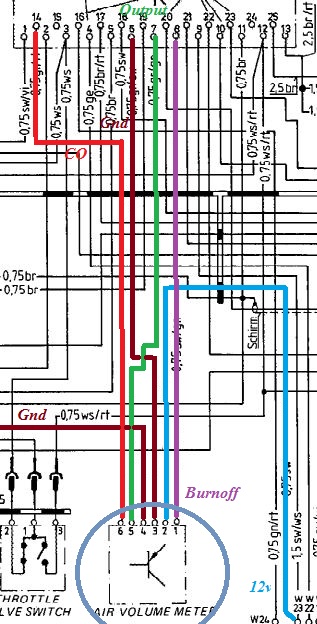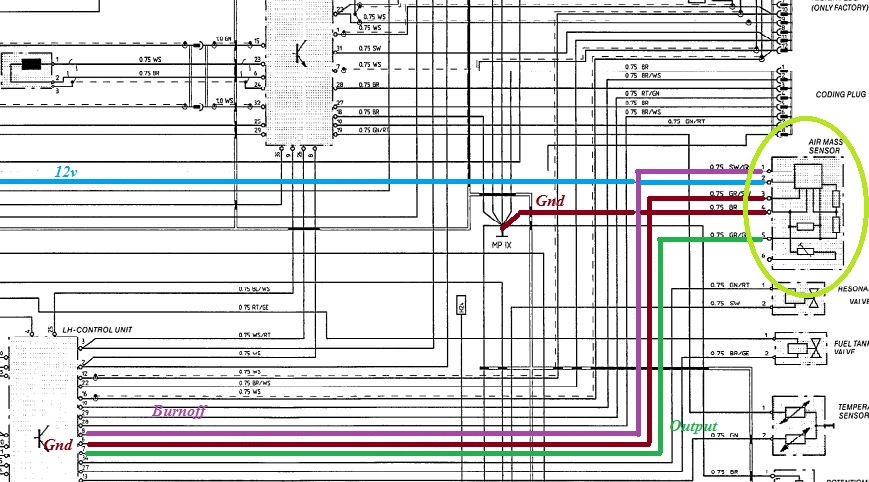
Does a new MAF have to be adjusted?
There is quite a bit of difference considering MAF connection between an early
S2/S3 model and a S4 model. The S4 model does not need CO adjustment at the MAF
whereas he S2/S3 models do need a CO adjustment using a hex-key potentiometer at
the side of the MAF housing. Here is a picture of a 1986 connection (first pic)
compared to the connection of a 1987 (second pic)


> I will be receiving a new MAF to replace the failed one and I am wondering if this has to be adjusted or it is set at the factory?
>
> Thanks,
> Darren 85S
==========
Darren,
Your car will run with a new MAF, even if it is not adjusted. However, there are adjustment procedures to fine tune the MAF. This needs to be done with the O2 sensor disconnected, using an Air fuel meter or a CO meter, preferably attached to the CO test pipes coming up from the exhaust near the rear of each valve cover. If you use an Air fuel meter adjust to about the middle of the range at idle. This is not perfect, but is close.
The procedure starts on page 24-204 in the shop manuals. (or 24-123)
Ken '86.5 928S
==========
My 1990 928GT is suffering from a quickly dying idling problem after
ignition. The engine cannot stay spinning without pushing the accelerator
pedal.
My 928GT has uniquely a transmission modification from a manual to an
automatic one. (The purpose is to adapt to the heavy local traffic
situation in Seoul, Korea)
Its idling with the gear in the position of “P” or “N” shortly stays at
800 rpm. Around 5 to 10 minutes after ignition, the idle begins to
fluctuate between 1000 rpm and 600 rpm, and then suddenly decreased below
200 rpm to stop the engine.
When I shift the gear to the “D” position, the engine dies even quicker.
When shifting the gear to the “D” position, the idle immediately decreased
to around 650 rpm and stays there for 1-2 minutes. Then, the idle begins
to fluctuate wildly between 1000 rpm and 400 rpm for 10 to 20 seconds
before the engine dies and becomes silent.
In order to fix this problem, I have attempted almost everything in vain.
I replaced the mass air sensor, the air filter, and the air intake boots
with new ones, thoroughly cleaned the whole intake manifold system with
new gaskets installed including the idle stabilizer, cleaned and checked
the whole fuel injector system including new spark plug substitution,
refurbished all the belt system including the TB, made sure no vacuum leak
with a vacuum measurement device, and finally changed the oil filter and
the engine oil with Castrol’s top-of-the-line synthetic oil.
After completing all the above things, the idle problem seems to
deteriorate further and the engine dies quicker. Even during driving, the
engine dies if I do not push down the accelerate pedal for a while to
cruise.
928 Gurus out there, please help me. What should I do?
John Yoon PARK
=========
Problem being solved.
First of all I would like to express my sincere gratitude for the very
kind helps, emails and concerns from respected 928 gurus, enthusiasts, and
fellow owners.
After receiving and considering all the emails and responses to my
problem, my mechanic and I pondered and reexamined all the assembly and
joints, hoses, etc. Two days ago, we did find a small screw hole in the
back of the MAF (this was supplied from the authorized Porsche importer to
Korea). It looks like a control screw to adjust the air flow into the
engine. Thus, we began to tamper with the screw hole by rotating it
clockwise and anti clockwise with rotated amount measurement. Such
rotating instantly changed idling stability by changing the air flow
amount into the engine. The RPM needle stays stably and the engine sounds
very constant. We set the screw for a leaner fuel mixture by rotating the
screw hole one and half anticlockwise for more air flow into the engine.
Now, my 928GT came back to life and returned to the road. I am very
pleased.
John Yoon PARK
========
There are questions about the CO/Idle adjustment on a MAF. Well, from the S4 model onwards the MAF adjustment is no longer used. The CO/Idle adjustment is managed by the LH and the CO pot (if fitted in non-lambda cars). It is easy to see, the connector actually misses the wiring to pin 6, which is the output for the adjustment.

--------
This contains a procedure for adjusting the CO when a lambda sensor is present: Blinkr.pdf